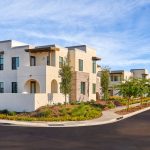David Obitz – Creating Affordable Housing That Doesn’t Look “Affordable”
GlobeSt.com
November 7, 2017
IRVINE, CA—The goal in making affordable housing not look “affordable” is most definitely to rise above the expectations of what many think of housing for those in need, KTGY Architecture + Planning principal David Obitz tells GlobeSt.com. In addition, shopping market-rate developments to get ideas and to see if they can incorporate those same elements on a more cost-efficient scale in their affordable communities is helpful to developers, Liane Takano, SVP of Related California, tells us.
KTGY designed the first affordable-housing communities—which were recently completed—for low-income families in Irvine’s master-planned community of Great Park Neighborhoods. The two communities, Luminaira at Parasol Park and Espaira at Parasol Park, are 100% leased and were developed by a collaborative effort between FivePoint Holdings LLC, Related California, Riverside Charitable Corp. and El Toro Housing Initiative Collaboration. FivePoint’s partnership, Heritage Fields LLC, is the master developer of Great Park Neighborhoods.
Located at 1158 Hamal in Irvine, Luminaira and Espaira communities offer a total of 166 affordable apartment homes for low-income families along with a 4,000-square-foot leasing and social-services center, complete with kitchen, media lounge, computer center, mailroom and play area. Other amenities include pool, barbeque and picnic pavilion, and dog run. On-site services will include after-school programs and educational classes. Essentially, the communities are indistinguishable from what many recognize as affordable communities.
We spoke with Obitz and Takano about how developers can create affordable-housing communities that don’t look affordable.
GlobeSt.com: How do developers approach affordable-housing design in a way that doesn’t make the project look “affordable”?
Takano: When we begin a development, we don’t think of it as “affordable housing.” Instead, we think about what is most important for both the community and potential residents and start by addressing their key needs.
For example, on the Irvine family sites, we worked with FivePoint on the design and, in particular, the scale and exterior elevations, in order for the developments to integrate seamlessly within the community. We wanted Luminaira and Espaira to be indistinguishable from the market-rate housing nearby. In addition, when coming up with a program or key components for the common areas, the team brainstormed what amenities would most be used by our residents and their pets (all of Related’s Irvine properties are pet friendly) and what type of social-services programming would best address the needs of our residents and help them successfully integrate into society.
Obitz: Often, designing affordable housing is a more liberating, free-thinking and creative process merely because the constraints of following the “norms” of market-rate housing are not necessary. This allows for higher thinking resulting in excellent solutions in the context of the community. While designing highly functional affordable homes, much thought and consideration are given to how the development will benefit the community plan and stakeholders, so the development directly gives back to its residents as well as the community. We are frequently complimented on our design of new affordable neighborhoods that don’t look affordable or are “seamless” with the neighborhood, but this doesn’t mean that they are a copy of what already exists, nor do we want them to look “ordinary.” The goal is most definitely to rise above the expectations of what many think of housing for those in need.
GlobeSt.com: How can developers decrease their costs while still maintaining a high-quality affordable product? Takano: It is a challenge, but Related has found a way by working closely with our design team, city staff and our general contractor. With a fixed budget, we splurged on the items that we knew would matter to the residents—amenities, interior finishes, etc.—then, we value engineered out those items that are not as critical. We cut costs by building efficient units, and we specified finishes that look like they belong in a market-rate development (e.g., vinyl plank was used to give the appearance of wood floors). Also, I often shop the market-rate developments, including the homes and common areas in the Great Park Neighborhoods, to get ideas and see if we can incorporate those same elements, on a more cost-efficient scale, in our affordable developments.
Obitz: Developers need to choose lasting, enduring design aesthetics; avoid temporary or short-lived trends;and use enduring materials that prolong life-cycles and create a sustainable residential community. Also, it is important to anticipate shifts in technologies and user behaviors and design reasonably flexible spaces without structural or systems gymnastics.
GlobeSt.com: What state and local programs can developers take advantage of in order to get these products done in a cost-efficient manner?
Takano: All of our affordable developments take advantage of tax credits that are administered through the California Tax Credit Allocation Committee. There are other federal, state and local financing programs/incentives/grants (e.g., HOME funds, Community Development Block Grants, City fee waivers, etc.), but each one comes with additional regulations and specific eligibility requirements, which may not be applicable to the development.
Obitz: Along with tax credits and government-based financial incentives, life-long project community outreach with stakeholders will help save time upfront during entitlements and permitting. Time is money, so community trust for your development team goes a long way. High-quality reputations for the developer and their consultant team is invaluable.
GlobeSt.com: What else should our readers know about affordable housing that doesn’t look affordable? Takano: It’s important to know how to strike that balance between “too many” and “too few” units. The higher the unit count, the more economies of scale/cost-efficiencies, but if the development doesn’t fit within the context of the surrounding community (e.g., scale is too large, architecture doesn’t match the surrounding community), it could segregate and cause social and economic impacts on our residents. Affordable housing, if done well and successfully, will address the social, emotional, physical and educational needs of the residents, and these needs can be further met if “affordable housing doesn’t look affordable.”
Obitz: Today’s affordable housing includes many of the same amenities that you would find in market-rate apartment communities. In addition to the typical clubroom and common areas found in most developments, affordable communities also include space for third-party non-profit programs. After-school programs and educational classes are among the many programs offered to residents. As architects, our goal is to design flexible spaces to accommodate as many uses as possible since the needs of the community and programs may evolve over time. The design of outdoor amenities is equally as important. Creating multi-use spaces such as turf areas that double as outdoor movie night seating is an efficient use of valuable open space and frees up room for the pool and playground areas, barbecues and picnic area, gaming areas and community gardens.



